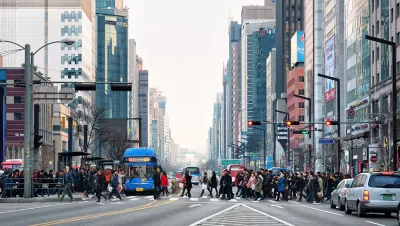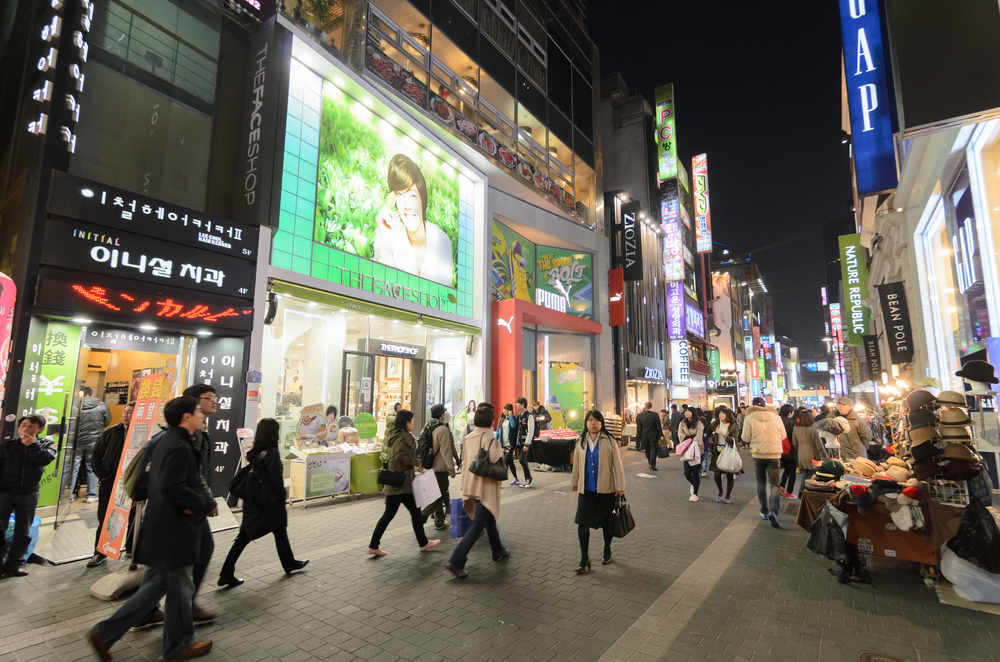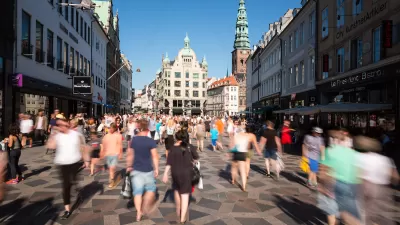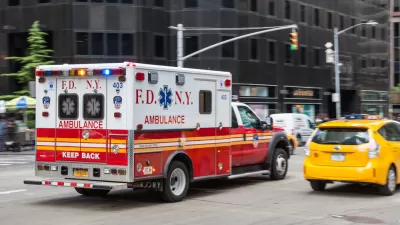A new article in the Journal of Planning Education and Research tests whether Jacob’s ideas ring true for predicting pedestrian vitality in Seoul.

Jane Jacobs may have written The Life and Death of Great American Cities, thinking of places in the United States like Greenwich Village in Manhattan, the Old North End in Boston, and the "shoe district" in Louisville, but her theories are now influential worldwide. What resonates is the universality of how the built environment contributes to pedestrian vitality. In particular, Jacobs highlighted the importance of diversity in terms of streets, buildings, and people, while offering guidance for good planning in the form of "mixed land uses, small blocks, buildings from many different eras, and sufficient building densities," which allow for vibrant activity throughout the day (Sung et al 2015).
Seoul, South Korea, is characterized by high levels of mixed land uses; its densities are higher than New York City and its transportation network is well developed, but the city is also under constant pressure from centralized redevelopment projects and traffic. A new article in the Journal of Planning Education and Research tests whether Jacob's ideas ring true for predicting pedestrian vitality in Seoul.

Hyungun Sung, Sugie Lee, and SangHyun Cheon test Jacob’s ideas by comparing the volume and composition of pedestrian and automobile trips in Seoul at different times of the day. The authors used Korean neighborhood units ("dongs"), which are approximately the same size as Jacob's ideal urban district. They developed several measures of land use mix and included other characteristics of the neighborhoods, such as the age of buildings, density, block size, and border vacuums (e.g., large obstacles, like highways or superblocks, which interrupt the street grid) in their analysis.
They found that short blocks, arranged in networks with four way intersections, promote pedestrian uses, and border vacuums harm the pedestrian environment. To test Jacob's hypothesis that vibrant districts also have activity through the day, the authors evaluated how various neighborhood characteristics contributed to having sustained pedestrian activity at different times. The evidence for this was mixed, as many areas within Seoul are 24-hour districts.

This paper largely confirms Jacob's theory of urban vitality as related to environments that promote pedestrian oriented communities. These results are consistent with the 5-Ds described by Robert Cervero (Density, Diversity, Design, Destination, and Distance to Transit), and confirmed in other empirical research of developments based on these principles, such as LEED-ND (Ewing et al 2013). That is to say that people in Korea respond to the built environment much in the same way as people in the United States.
Seoul or New York are certainly not examples for every community, but these results may also remind planners that fixtures of American development practices and regulation, such as, single-use zoning, superblocks linked by arterials, street design, and subdivision ordinances that discourage connectivity and suppress density may be insurmountable barriers to vibrant street life.
The authors of the paper are, respectively, from Chungbuk University, Cheongju, Korea, Hanyang University, Seoul, Korea, and HongIk University, Seoul, Korea.

Manufactured Crisis: Losing the Nation’s Largest Source of Unsubsidized Affordable Housing
Manufactured housing communities have long been an affordable housing option for millions of people living in the U.S., but that affordability is disappearing rapidly. How did we get here?

Americans May Be Stuck — But Why?
Americans are moving a lot less than they once did, and that is a problem. While Yoni Applebaum, in his highly-publicized article Stuck, gets the reasons badly wrong, it's still important to ask: why are we moving so much less than before?

Using Old Oil and Gas Wells for Green Energy Storage
Penn State researchers have found that repurposing abandoned oil and gas wells for geothermal-assisted compressed-air energy storage can boost efficiency, reduce environmental risks, and support clean energy and job transitions.

Greening Oakland’s School Grounds
With help from community partners like the Trust for Public Land, Oakland Unified School District is turning barren, asphalt-covered schoolyards into vibrant, green spaces that support outdoor learning, play, and student well-being.

California Governor Suspends CEQA Reviews for Utilities in Fire Areas
Utility restoration efforts in areas affected by the January wildfires in Los Angeles will be exempt from environmental regulations to speed up the rebuilding of essential infrastructure.

Native American Communities Prepare to Lead on Environmental Stewardship
In the face of federal threats to public lands and conservation efforts, indigenous groups continue to model nature-centered conservation efforts.
Urban Design for Planners 1: Software Tools
This six-course series explores essential urban design concepts using open source software and equips planners with the tools they need to participate fully in the urban design process.
Planning for Universal Design
Learn the tools for implementing Universal Design in planning regulations.
Heyer Gruel & Associates PA
City of Moreno Valley
Institute for Housing and Urban Development Studies (IHS)
City of Grandview
Harvard GSD Executive Education
Salt Lake City
NYU Wagner Graduate School of Public Service
City of Cambridge, Maryland
































